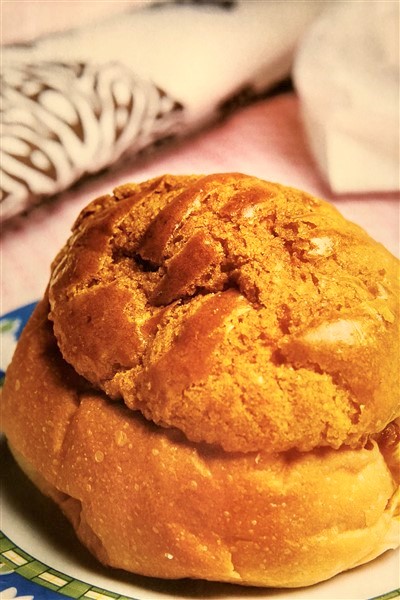Pineapple Buns (Bolo Bao)
Pineapple Buns: an Iconic Cantonese Pastry
Pineapple buns, also known as Bolo Bao in Cantonese, are sweet pastries that began in Hong Kong and eventually spread to Guangdong. Baking makes its surface golden brown, and its crispy, uneven exterior resembles a pineapple, thus giving its name. Pineapple buns are best known for their flaky crust. To make authentic pineapple buns, the crust must be crispy and sweet, but the bun itself must be soft.

Ingredients
- 2 cups (250 grams) bread flour
- 1 ¼ cups (150 grams) low gluten flour
- 2 eggs
- 1/4 cup (60 grams) butter
Seasonings
- 1 scant teaspoon (3 grams) yeast
- 1/3 cup (60 grams) sugar
- 1 heaping teaspoon (5 grams) salt
Cooking Directions
How to make the dough
- Activate yeast with a bit of warm water. Allow butter to soften at room temperature. Beat 1 egg.
- Mix bread flour with a little less than 1/2 cup (50 grams) low gluten flour. Sprinkle activated yeast evenly over flour. Crack one egg into flour. Add 1/6 cup (30 grams) sugar and 1 heaping teaspoon (5 grams) salt. Use chopsticks to stir evenly in one direction to create a dough with a smooth surface. Add 1 tablespoon (60 grams) butter, and continue mixing until smooth. Cover with plastic wrap. Let ferment for 30 minutes, or until dough doubles in size.
- Divide dough into pieces 1.76 ounces (50 grams) each. Knead into balls. Let sit for 10 minutes.
How to make pineapple bun crust
- Mix 3 tablespoons (45 grams) butter and 1/6 cup (30 grams) sugar until the mixture turns white and swells. Add bits of the previously beaten egg in three parts (leave a bit of beaten egg to use later for brushing over the uncooked pineapple buns). Stir.
- Note: Each time you add a bit of egg, mix it sufficiently with the butter before adding a bit of the same amount of egg. This will prevent the butter and water from separating and affecting the crispiness/flakiness of the pineapple bun.
- Add 1 scant cup (100 grams) low gluten flour to the mixture created in step 4. Stir to create a dough with a smooth surface. Divide dough into pieces 0.35 ounces (10 grams) each. Knead into balls, then use rolling pin to roll flat into thin, circular sheets. This is the pineapple bun crust.
Put it all together
- Wrap the dough balls from step 3 with the pineapple bun crust. Press the crust slowly out in all directions so that it covers 1/2 of the dough balls surface. Use a knife to cut lattice patterns into the pineapple bun crust. Let ferment until these double in size, thus creating the uncooked pineapple buns.
- Preheat oven to 356°F (180°C). Place a sheet of aluminum fool over baking sheet. Place pineapple buns on top, leaving ample space between each one. Bake for approximately 20 minutes. Remove from oven and brush a layer of beaten egg over pineapple buns. Bake for another approximately 3 minutes. Serve.
The Evolution of Pineapple Buns
Chinese people put a lot of stock in interpersonal relations, and many of their customs reflect this, such as the custom of going from village to village over the New Year visiting friends and relatives. This tradition involves making refined, home-cooked dim sum snacks to serve to those closest in our lives.
The pineapple bun is a classic example of the type of constant evolution that occurs within this kind of dim sum culture.
Some of the pineapple bun innovations that people have pioneered include luncheon meat pineapple buns, mini pineapple buns, buttered pineapple buns, nori pineapple buns, red bean pineapple buns, desiccated coconut pineapple buns, and barbecue pork pineapple buns. There are even pineapple buns which include actual pineapple as a filling.
A simple innovation – placing fresh, delicious fruit between the sweet pastry – can liven up the dish, making it more appealing to a greater number of people. After each meal, this innovative, tasty dim sum snack is a must-order dessert that serves as a model for all other pastries to follow.